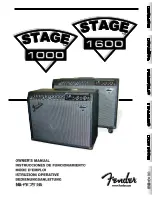
_____________________________________________________________________
WYRED 4 SOUND ST Preamp v2.2
4235 Traffic Way
Atascadero, CA 93422
PH: 805-466-9973
FAX: 805-462-8962
www.wyred4sound.com
©2013 WYRED 4 SOUND
All rights reserved.
Page 7 of 12
“
“
B
B
r
r
e
e
a
a
k
k
-
-
i
i
n
n
”
”
p
p
e
e
r
r
i
i
o
o
d
d
Your new preamplifier will deliver outstanding performance right out of the box. However, you should
plan on improvements as it reaches its normal operating temperature and once all of the components have a
chance to “settle in”. Our experience has shown that the STP has reached its’ potential after the initial 200 hours.
One will find that the initial 100hours, the unit will start to shed the initial “brightness” and somewhat harsh
transitions. During the second 100 hours, the preamplifier will start to become more fluid, and smoother overall.
Additional time is where the lesser of a change happens, and you will come to enjoy your new product for years to
come. After the initial break in period, your unit will be ready to perform when powered on.
T
T
r
r
o
o
u
u
b
b
l
l
e
e
s
s
h
h
o
o
o
o
t
t
i
i
n
n
g
g
No sound?
If you have your input source and speakers connected, and you can’t get music to play, check the following:
1. Verify that the power cord is plugged in and that the outlet is powered up.
2. Check the front panel and make sure that the display lights up.
3. If the display is on and there still isn’t any sound, adjust the volume. You should here some mechanical
noise of the relays clicking inside the unit. If you still don’t get sound when the volume is raised, make
sure the proper input is selected.
4. If you can hear the preamplifier turn on and off, but there still isn’t any sound, make sure you are
getting a signal to it.
5. Verify that the input is selecting the proper input for what you have connected.
6. If the input is in the proper position and still no sound, then try replacing the interconnects to verify the
connection between the preamplifier and source.
7. Verifiy that the interconnects are conducting by replacing them on a different set from a connection that
you know works.
8. Now that you have interconnects that you know work, try connecting the preamplifier to another source
that you know has worked in the past.
If you are still experiencing problems after checking all possibilities and using the resources provided please
contact your dealer or Wyred 4 Sound directly for further assistance.
G
G
o
o
t
t
h
h
u
u
m
m
?
?
Is there too much hum or hiss coming out of your speakers? If you put your ear right next to the tweeter
of your speaker, you should barely be able to hear any hiss in normal conditions, depending on amps. If the
noise is easily heard at a distance, try putting your source on mute, or pause. If this eliminates the noise, it’s
inherent in the source. If the noise is still there when the preamplifier is muted, try disconnecting the inputs to
the amplifier. If the noise is still there when the inputs are disconnected, and the inputs are shorted with shorting
plugs, then your amplifier may need some servicing. If the noise is not there when the inputs are disconnected,






























